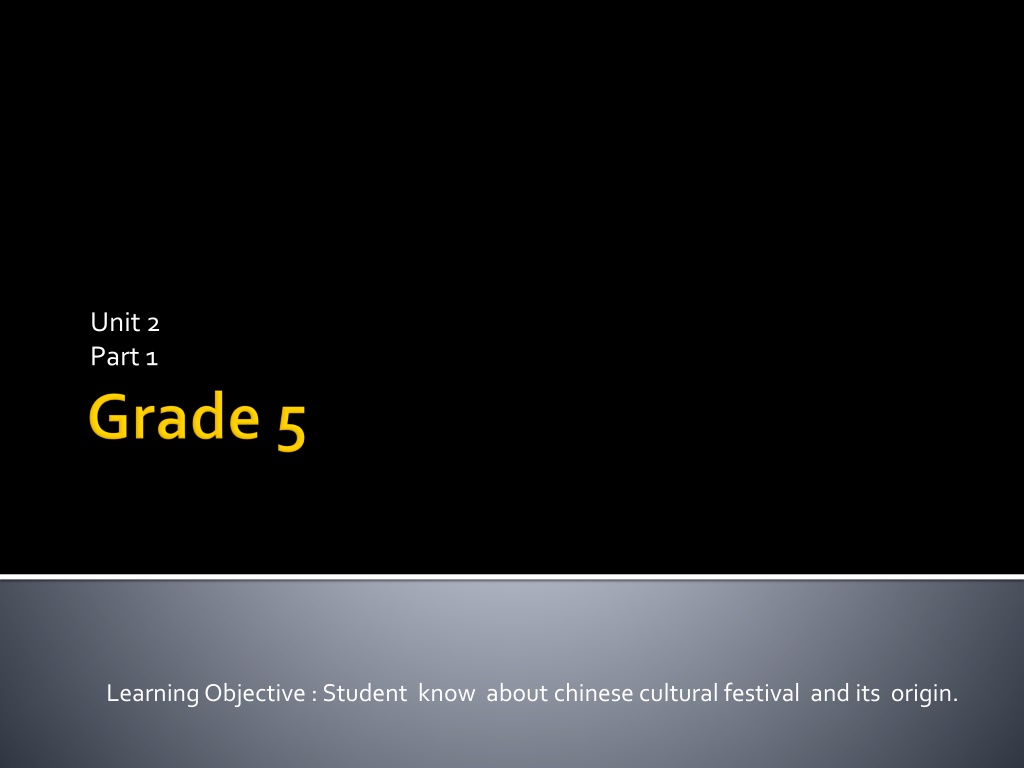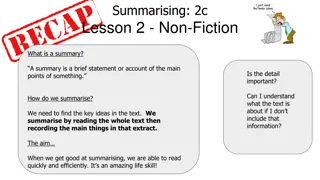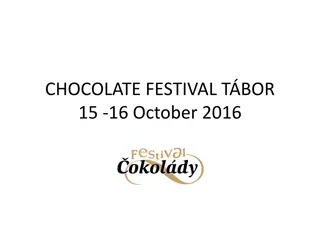Understanding the Chinese Mid-Autumn Festival
The Mid-Autumn Festival is a significant East Asian harvest celebration, observed on the 15th day of the 8th lunar month, featuring the beauty of a full moon in late September to early October. This tradition involves family gatherings, festive meals, and historical rituals rooted in Chinese cultural heritage, honoring the moon's symbolism and abundance of the season.
Uploaded on Sep 13, 2024 | 0 Views
Download Presentation

Please find below an Image/Link to download the presentation.
The content on the website is provided AS IS for your information and personal use only. It may not be sold, licensed, or shared on other websites without obtaining consent from the author. Download presentation by click this link. If you encounter any issues during the download, it is possible that the publisher has removed the file from their server.
E N D
Presentation Transcript
Unit 2 Part 1 Learning Objective : Student know about chinese cultural festival and its origin.
TheMid-Autumn Festival is anEast Asianharvest festivalcelebrated notably by theChineseandVietnamese[2][3]people. The festival is held on the 15th day of the 8th month of thelunar calendarwithfull moon at night, corresponding to late September to early October of theGregorian calendarwith a full moon at night.[2]
A lunar calendar is acalendar based upon the monthly cycles of the Moon's phases (synodic months), in contrast to solar calendars, whose annual cycles are based only directly upon thesolar year. The most commonly used calendar, theGregorian calendar, is a solar calendar system that originally evolved out of a lunar calendar system. A purely lunar calendar is also distinguished from alunisolar calendar, whose lunar months are brought into alignment with the solar year through some process of intercalation. The details of when months begin varies from calendar to calendar, with some usingnew,full, or crescent moons and others employing detailed calculations. https://en.wikipedia.org/wiki/Lunar_calendar
Zhngqi ji zh ngqi ji ji
The Mid-Autumn Festival falls on the 15th day of the 8th lunar month. The moon looks extremely round, big and bright on the 15th day of each lunar month. People selected the August 15 to celebrate because it is a season when crops and fruits are all ripe and weather pleasant. On the Mid-Autumn Festival, all family members or friends meet outside, putting food on tables and looking up at the sky while talking about life.
The festival has a long history. In ancient China, emperors followed the rite of offering sacrifices to the sun in spring and to the moon in autumn. Historical books of the Zhou Dynasty had had the word Mid-Autumn. Later aristocrats and literary figures helped expand the ceremony to common people. They enjoyed the full, bright moon on that day, worshipped it and expressed their thoughts and feelings under it. By the Tang Dynasty (618-907), the Mid- Autumn Festival had been fixed which became even grander in the Song Dynasty (960-1279). In the Ming (1368-1644) and Qing (1644-1911) dynasties, it grew to be a major festival.
There is a legend of the origin of Mid-Autumn Festival. In remote antiquity, there were ten suns rising in the sky, which scorched all crops and drove people into poverty. A hero named Hou Yi was much worried about this, so he ascended to the top of the Kunlun Mountain and, directing his superhuman strength to full extent, drew his extraordinary bow and shot down the nine superfluous suns one after another. He also ordered the last sun to rise and set according to time. For this reason, he was respected and loved by the people and lots of people of ideals and integrity came to him to learn martial arts from him. A person named Peng Meng lurked in them.
Hou Yi had a beautiful and kindhearted wife named Chang E. One day on his way to the Kunlun Mountain to call on friends, he ran upon the Empress of Heaven who was passing by. Empress presented to him a parcel of elixir, by taking which, it was said, one would ascend immediately to heaven and become a celestial being. Hou Yi, however, hated to part with his wife. So he gave the elixir to Chang E to treasure for the time being. Chang E hid the parcel in a treasure box at her dressing table when, unexpectedly, it was seen by Peng Meng. One day when Hou Yi led his disciples to go hunting, Peng Meng, sword in hand, rushed into the inner chamber and forced Chang E to hand over the elixir. Aware that she was unable to defeat Peng Meng, Chang E made a prompt decision at that critical moment. She turned round to open her treasure box, took up the elixir and swallowed it in one gulp. As soon as she swallowed the elixir her body floated off the ground, dashed out of the window and flew towards heaven. Peng Meng escaped.
The Mid-Autumn Festival is the second most important traditional festival in China (the most important one is Chinese New Year). It's a family day in China, something like Thanksgiving Day. There are many traditional and new celebrations. Read on to see how Chinese people celebrate the Mid-Autumn Festival.
As the Mid-Autumn Festival represents the reunion of families, families will have dinner together on that night. People who don't have time to stay with their parents will try their best to go home to at least have dinner together. Therefore, there can be traffic jams during this festival.
A mooncake is a traditional Chinese pastry. It is made from wheat flour and sweet stuffing, such as sugar and lotus seed powder. It's a symbol of family reunion, and the cake is traditionally cut into pieces that equal the number of people in the family.. Eating mooncakes is the most common and representative tradition of the day. In ordinary times, people won't buy or eat mooncakes but during the Mid-Autumn Festival everyone will have a mooncake to celebrate.
In Chinese beliefs, the full moon is the symbol for a family reunion. Many famous ancient poets wrote poems about the moon and expressed their homesickness. When people look at the moon, it reminds them of their families and homeland.. Nowadays, people still like appreciating the moon during the Mid-Autumn Festival in China. Chinese family members have dinner together in the evening of the Mid-Autumn Festival. After dinner, they may talk about their work, the children, and their future plans.
After dinner, every family will put a table outside the door, or in the courtyard. They put mooncakes, fruit, incense, and candlesticks on the table, facing towards the moon. Nowadays, this tradition is disappearing. It's rare to see families worshiping the moon in big cities. In some old towns or tourist cities, people will hold a ceremony to worship the moon in a square, park, or street, but this is more like a performance. Fruit for worshiping the moon includes a watermelon, grapefruit, pomegranate, pear, persimmon, grapes, or other seasonal fruit.
Making colorful lanterns is a happy activity between families and children. The lanterns have different shapes and can also resemble animals, plants, or flowers. Children love making colorful lanterns. They make them in different shapes to be hung in trees or houses, or floated on rivers. Parks will also hang up colorful lanterns, which provide a beautiful view at night. They also make Kongming lanterns, which can fly because the burning candles heat the air in the lantern. Children write good wishes on the lanterns and let them fly up into the sky.
It's very popular to give gifts to friends and relatives during the Mid-Autumn Festival. During the festival, people will pay short visits to friends or relatives, taking gifts with them. They usually leave before dinnertime. This is a good time to get closer to friends and relatives. Companies also like to give a gift to every staff member. The most popular and common gifts are mooncakes and fruit.
People who are used to using phones will send celebration messages to friends, relatives, or people who are far away. It's also a good way to break the ice if you don't know how to start a conversation by phone. In the past, people sent SMS. Nowadays, young people like to send messages via instant messaging apps, such asWeChat or QQ.
The Mid-Autumn Festival is not only a traditional Chinese festival but is also a public holiday for Chinese people. Usually, the Chinese will have three days off including a weekend. Therefore, people can go on short trips with family or friends. Usually, a couple of weeks or a month before the festival, people will plan their tour to cities around their home or office. And during the 3- day holiday, train tickets are likely to be sold out in advance quickly.
During almost every big holiday, there will be discounted promotions in supermarkets, shopping malls, and online shops. During the Mid-Autumn Festival, supermarkets will have lottery draws for mooncakes using the consumers' receipts. And because the weather is cooling down, there will also be big summer sales in the shopping malls. Young people are more likely to go shopping for clothes and to enjoy the big discounts, with online shopping being the most popular type.
Watching a movie is not a tradition for any festival as you can do this at any time. But when people don't have other plans and want to find a way to celebrate the festival, watching a movie is a good idea. Usually, families or couples will watch movies after dinner. After shopping for a whole day, young people may also prefer to watch a movie to rest their legs.
To draw based on sample of pictures provided or draw by your own imagination related Moon Cake Festival. Rewrite the poem provided in your drawing. https://so.gushiwen.org/shiwen v_e38b61012996.aspx























